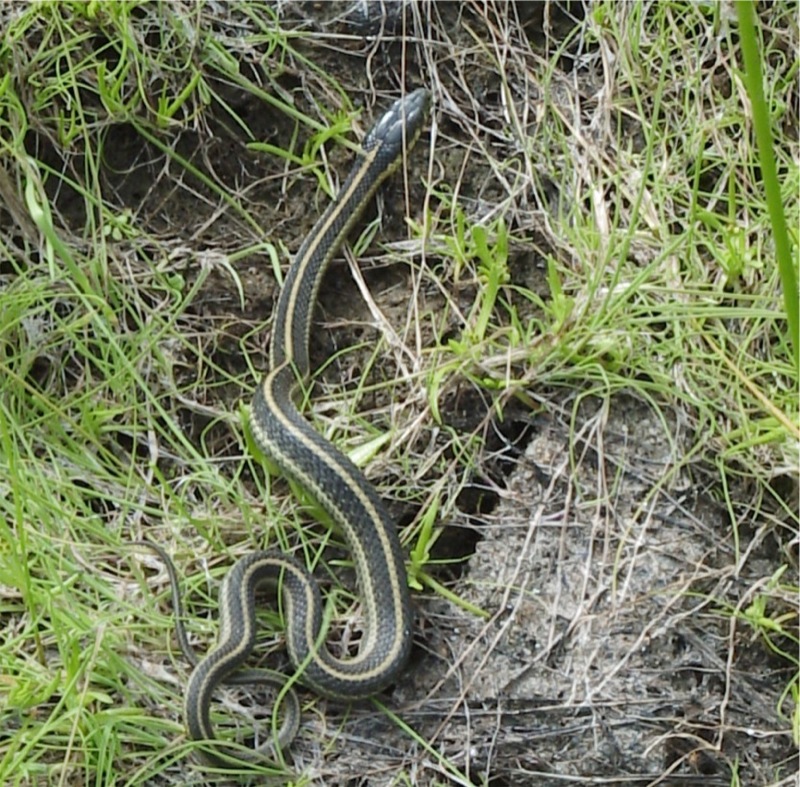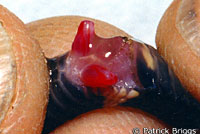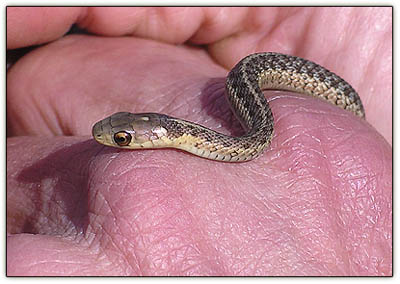After watching a show featuring garter snakes a few months ago, I knew I needed to write an entry on these charming reptiles!
Do you like snakes or are you scared of them? When and where was the last time you saw one?
Apparently as a little girl of three years old, I walked up to my Mom excitedly holding a snake! I'm assuming she told me to put it down.

The Eastern garter snake.
The most widely distributed reptile in North America, garter snakes range from the Gulf of Mexico to Canada, and are the only snake found in Alaska. These snakes are obviously very adaptable, living in prairies, forests, rocky heights and wetlands.
Within the Thamnophis genus there are many species and varieties of garter snakes, some of which are disputed by scientists. Only one garter snake species is endangered: the San Francisco garter snake.

Oooh, pretty!
Garter snakes are 24 to 53 inches long, weighing about 5.28 oz. Most garter snakes have one to three light-colored vertical stripes down their body, while some have patterns between the stripes. The background color of their scales can range from black, gray, brown and olive. Back in the day folks thought these narrow, striped snakes resembled garters, and the name stuck. Here is a pretty MN native, the red-sided garter snake:

Like most snakes, garter snakes are predators. They find food by moving around their territory, particularly in cool mornings, afternoons, and evenings. Using vision, vibration detection and sense of smell, garters search out slugs, worms, bugs, eggs, lizards, birds, spiders and rodents. An aquatic garter snake will also eat tadpoles, frogs, fish and leeches. Many people consider garter snakes helpful as they will dine on garden and yard pests.
Because of their diet, garter snakes are affected by pesticides and water pollution. Other enemies include mink, hawks, crows, crayfish, other snakes, herons, raccoons, snapping turtles and domestic cats. Baby garters are preyed upon by shrews and frogs.
Garter snakes are mostly independent during the warm months. They communicate by excreting pheromones to each other, or leaving pheromone trails. Because of the cold here in MN, and further north, garter snakes hibernate together during the winter, finding traditional hidey-holes that stay between 37 and 39 degrees fahrenheit. This process is called brumation, which varies metabolically from actual hibernation. On warm winter days garters will occasionally come out to sun themselves on rocks.
In the spring, garters wake up from brumation horny! Often the males will emerge first, lying in wait for the females to emerge a few days or weeks later. She will emit a sex pheromone, and the snakes form a writhing mating ball!

To assist in successful copulation, male garter snakes (and all snakes) have two penises! Each hemipenis is attached to its own sexual glands. Apparently only one penis is used at a time, however!

(Don't worry; the above snake is not being harmed. Gently "popping" out the hemipenes is a definitive way to sex a snake.)
Some male garter snakes are born with both male and female pheromones. These "she-males" emit their female scent while in a mating ball, presumably to distract the other males from the ladies. Once a male has ejaculated inside a female snake, he leaves a mucous plug inside her cloaca to block other males. She also stops emitting the sex pheromone, and can leave the mating ball to find a suitable place to eat and bear her babies.
If the female garter snake isn't feelin' any of the dudes, she can simply use sperm she might have saved from the previous autumn!
After two to three months, the female garter snake gives birth to three to fifty live babies. The juvenile snakes are 5 to 9 inches long, and independent immediately after being born. Being small and vulnerable, baby snakes often die in their first year.

Cuteness!
Contrary to popular belief, garter snakes do produce venom. However, their small rear fangs lack the venom grooves to deliver poison to the enemy, and they don't possess the giant front fangs a rattlesnake or viper has. A garter snake has to sort of chew the enemy to deliver their mild neurotoxin. Most garter snakes will retreat when approached, but will occasionally strike. They can also be tamed and make good pets!
I hope you've learned something about garter snakes, and will send them happy vibes the next time you see one! I know I'm always excited to spy a snake. Maybe you will like them more if you think of their twin penises!?
Whither do they slither,
Wendell!

3 comments:
w, my last snake encounter was in montana last summer. we had a serpentine visitor seeking sun on our deck. wow, the picture of the hemipenes. bright red?! gawd. hugs and critters, s
I'm wondering why the red sided garter in your image above has a triangular head like a poisonous snake.
Just saw one of these on a trail in Whipple Creek Park, near Ridgefield, WA. Walked right by him! Very fast, very beautiful creature.
Post a Comment